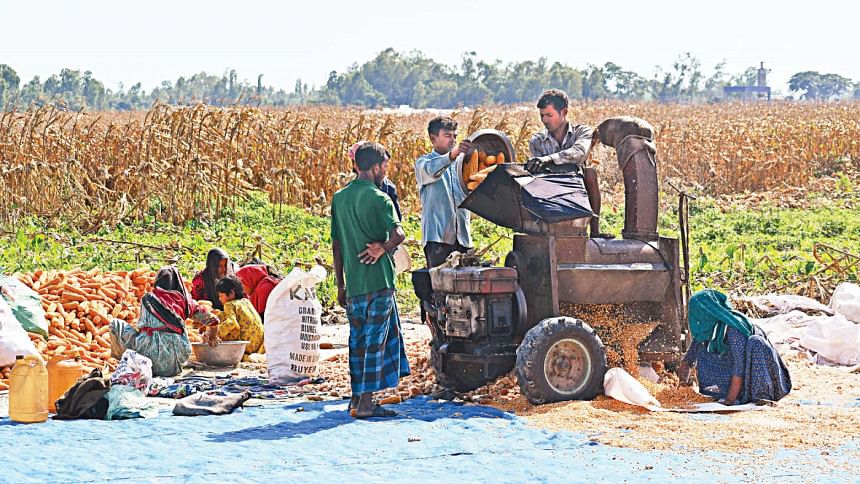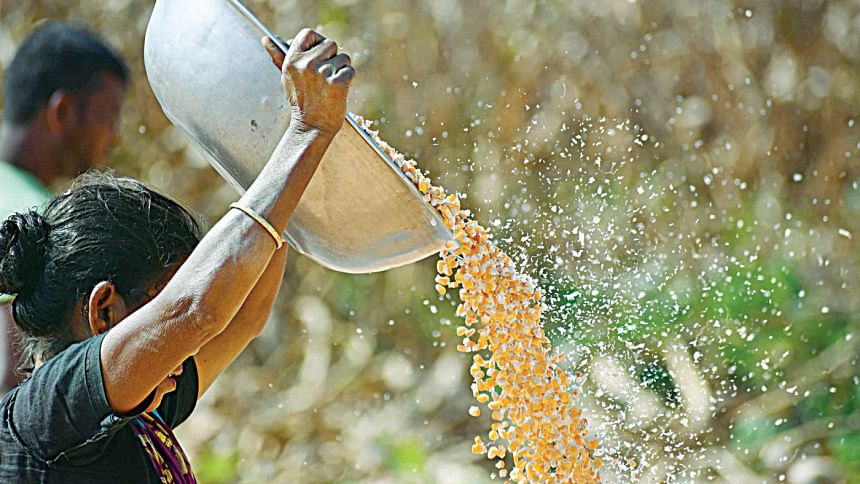Char farmers see rising profits from maize

Hundreds of maize farmers based in char areas of the Brahmaputra, Teesta and Jamuna rivers in Gaibandha are overjoyed to get bumper yields and good prices this year.
Farmers say that favourable weather conditions helped ensure good harvests while the coronavirus pandemic pushed up prices by more than double of previous levels.
According to the Department of Agricultural Extension (DAE) in Gaibandha, local farmers have cultivated maize on 17,012 hectares of land across seven upazilas of the district, particularly its char areas.
And considering the good yields and low cost of cultivating maize, more farmers are getting interested to grow the cereal crop, a DAE official said.
During a recent visit to several char areas of Fulchhari upazila, where farmers cultivated maize on more than 5,000 hectares of land, it was found that many of them were happily harvesting, threshing and selling the grain right from their fields.
Khaza Mia, a resident of Ghodah village who cultivated three bighas of maize in the upazila's Purbo Vashar Char of Brahmaputra river, said he got about 40 maunds of the crop by harvesting half his field so far.

"We got bumper yields this year at a time when the price of maize is more than Tk 1,200 per maund (37 kilogrammes)," he added.
Khaza went on to say that yields were poor last year due to bad weather while prices were below Tk 700 per maund.
Saleha Begum, a farmer in Satarkandir Char of Brahmaputra river, said she has cultivated two-and-a-half bighas of maize this season to get yields of about 40 maunds per bigha.
"I sold one bigha of maize for Tk 50,000 and am very happy with it," Saleha added.
Tara Mia, another farmer of Vashar Char, said he cultivated 16 bighas of maize at a cost of about Tk 12,000 per bigha.
The char areas just above the banks of rivers in the region were abandoned just five years ago but farmers have since started cultivating maize in these lands as it requires low investment and maintenance but provides good returns.
"So, maize cultivation is becoming a blessing for char farmers," he added.
Aminul Islam, a farmer of Satarkandi Char, said yields were poor last year as a heatwave burned up the crops just before they could mature.
"I got only 15 to 20 maunds of maize per bigha last year. Besides, many farmers counted losses as the price was just Tk 650 per maund back then. This year though, farmers are happy with bumper yields and unexpectedly high prices," he added.
Farmers in Bogura have also expanded maize cultivation by planting the crop on 8,750 hectares of land this year compared to 6,500 hectares in 2021, DAE data showed.
"Our yield target was only 32 maunds per bigha but farmers are getting an average of 40 maunds per bigha," said Md Anamul Haque, additional deputy director (crop) of the Bogura DAE.
While maize cultivation is already a comparatively inexpensive venture, the government is giving subsidies to encourage more farming.
"We gave hybrid seeds and fertilisers to some 20,000 farmers in Bogura last year. So, farmers in every district are being encouraged to increase maize cultivation," Haque added.
Most of the maize consumed in Bangladesh was previously imported from Ukraine, where the ongoing war with Russia has limited exports of the crop.
Maize, which was not familiar to farmers even in the early 90s, is now the second largest crop after rice as the grain has become a cash crop thanks to rising purchases by local mills to make feed for livestock and aquaculture, which requires about 75 lakh to 80 lakh tonnes annually.
However, this increasing demand has not only pushed up prices, but also encouraged growers to expand maize cultivation at the cost of wheat farming.
Wheat was previously grown on more than 6,000 hectares of land in the region but cultivation has since dropped to 2,100 hectares considering the crop's comparatively low profitability and yield, Haque said.
"So, within a short time, the price of maize has almost doubled and it will increase more," the DAE official added.
On a national scale, farmers planted maize on 3.77 lakh hectares of land as of January 6 this year, up 3.5 per cent from 3.64 lakh hectares as of January 3 in 2021, as per DAE data.

 For all latest news, follow The Daily Star's Google News channel.
For all latest news, follow The Daily Star's Google News channel. 



Comments